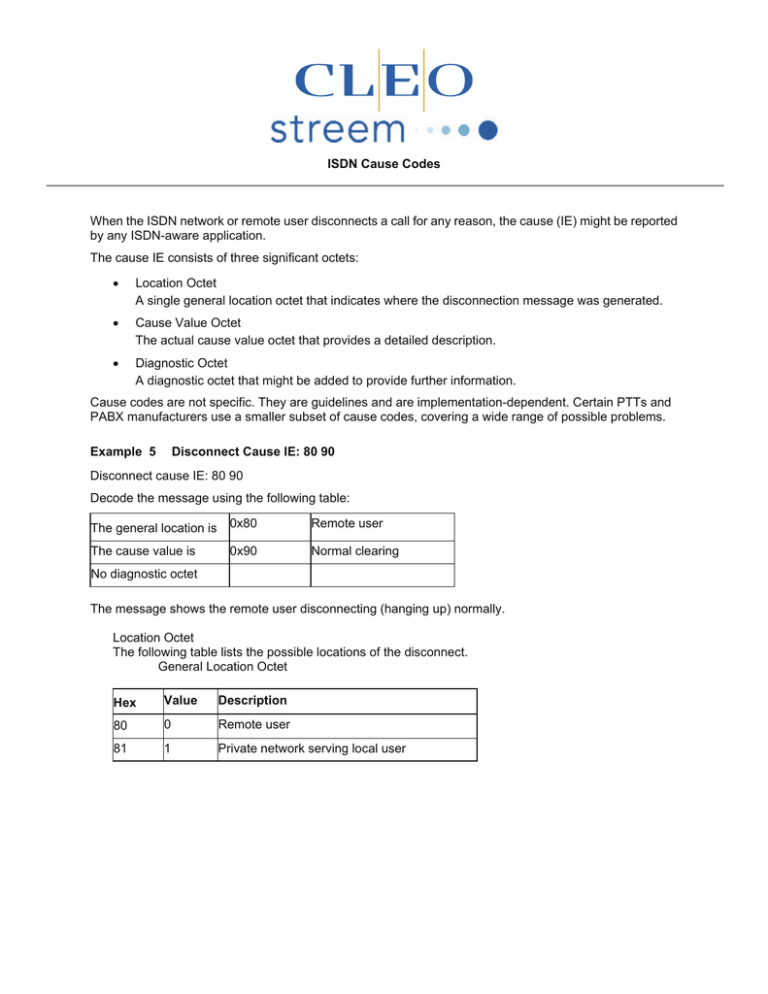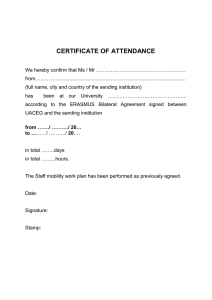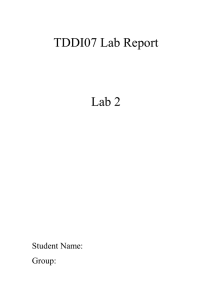
ISDN Cause Codes
When the ISDN network or remote user disconnects a call for any reason, the cause (IE) might be reported
by any ISDN-aware application.
The cause IE consists of three significant octets:
•
Location Octet
A single general location octet that indicates where the disconnection message was generated.
•
Cause Value Octet
The actual cause value octet that provides a detailed description.
•
Diagnostic Octet
A diagnostic octet that might be added to provide further information.
Cause codes are not specific. They are guidelines and are implementation-dependent. Certain PTTs and
PABX manufacturers use a smaller subset of cause codes, covering a wide range of possible problems.
Example 5
Disconnect Cause IE: 80 90
Disconnect cause IE: 80 90
Decode the message using the following table:
The general location is
0x80
Remote user
The cause value is
0x90
Normal clearing
No diagnostic octet
The message shows the remote user disconnecting (hanging up) normally.
Location Octet
The following table lists the possible locations of the disconnect.
General Location Octet
Hex
Value
Description
80
0
Remote user
81
1
Private network serving local user
82
2
Public network serving local user
83
3
Transit network
84
4
Public network serving remote user
85
5
Remote private network
87
7
International network
8A
10
Network beyond internetworking point
Cause Value Octet
The Cause Codes are grouped by class number.
Class 000 — Normal Events, see Table page61 on page 2
Class 010 — Network Congestion, see Table page63 on page 4
Class 011 — Service or Option Not Available, see Table page64 on page 4
Class 100 — Service or Option Not Implemented, see Table page64 on page 5
Class 101 — Invalid Message, see Table page65 on page 6
Class 110 — Protocol Error, see Table page66 on page 7
Class 111 — Interworking, see Table page67 on page 8
Table 10
Class 000 — Normal Events (Continued)
Hex
Value
Description
Meaning
81
1
Unallocated number Indicates that the requested destination, although
valid, cannot be reached.
82
2
No route to specified Sending equipment (sending the cause) is requested
network
to route call through an unrecognized transit network.
83
3
No route to
destination
Called user cannot be reached because the network
does not serve the destination.
86
6
Channel
unacceptable
The last identified channel is not acceptable to the
sending entity.
87
7
Call awarded
Incoming call is connected to a channel already
established fro similar calls (for example:
packet-mode X.25 virtual calls).
90
16
Normal clearing
Call is cleared by one of the users involved.
91
17
User busy
Called user cannot accept another call although
compatibility is established.
92
18
No user responding
When a user does not respond to call establishment
messages with either an alerting or connect
indication within the allowed time.
93
19
User altering, no
answer
User provided an alerting indication but has not
provided a connect indication within the allowed time.
95
21
Call rejected
Equipment sending the cause does not want to
accept this call although the equipment is busy or
incompatible.
96
22
Number changed
Indicates called party number is not assigned.
9A
26
Nonselected user
clearing
User not awarded the incoming call.
9B
27
Destination out of
order
Destination interface is not functioning correctly. The
cause has special significance with the TR114 ISDN
board. This message usually indicates a failure to
establish layer 2. Other symptoms include a failure to
fax to any number and a failure to answer any calls.
Typically caused by either physical cable problems or
an incorrect datalink protocol. Change the datalink
protocol, using briconf. If the error message still
persists, check the cable connection. Use the
onboard protocol analyzer to determine the exact
nature of the problem.
9C
28
Invalid number format Called party number is invalid or incomplete.
9D
29
Facility rejected
9E
30
Response to STATus The reason for generating the STATUS message
ENQuiry
was the prior receipt of a STATUS ENQUIRY
message.
9F
31
Normal unspecified
Network cannot provide the facility requested.
Used to report normal events only when no other
cause in the normal class applies.
Class 010 — Network Congestion (Continued)
Hex
Value
Description
Meaning
A2
34
No channel available An appropriate channel is not currently available to
handle the call.
A3
35
Call queued (AT&T)
A6
38
Network out of order Network is not functioning. Immediate redial is unlikely
to succeed.
A9
41
Temporary failure
AA
42
Switching equipment Switching equipment generating this cause is
congestion
experiencing a period of high traffic. AB 42 user
information is discarded. The network can not deliver
access information to the remote user as requested.
For example:
Network is not functioning. Immediate redial is unlikely
to succeed.
Network is not functioning. Immediate redial is unlikely
to succeed.
a user-to-user information
low-layer compatibility
subaddress as indicated in the diagnostic
The particular type of discarded access information is
optionally included in the diagnostic.
AC
44
Requested channel
not available
The channel indicated by the requesting entity cannot
be provided by the other side of the interface.
AF
47
Resources
unavailable or
unspecified
A resource unavailable event only when no other cause
in the resource unavailable class applies.
Class 011 — Service or Option Not Available (Continued)
Hex
Value
Description
Meaning
B1
49
Quality of service
unavailable
Throughput or transit delay cannot be supported. The
Quality of Service (as defined in Recommendation
X.213) cannot be provided.
B2
50
Requested facility not Requested supplementary service not provided by
subscribed
the network because the user has not completed the
necessary administrative arrangements with its
supporting networks.
B4
52
Outgoing calls barred
(AT&T)
B6
54
Incoming calls barred
B9
57
Bearer capability not User is trying to make unauthorized use of equipment
authorized
providing a bearer capability.
BA
58
Bearer capability not User has requested a bearer capability that is
presently available
implemented by the equipment generating the cause,
but is not available at this time.
BF
63
Service or option not A service or option not available event only when no
available or
other cause in the service or option not available
unspecified
class applies.
Class 100 — Service or Option Not Implemented
Hex
Value
Description
Meaning
C1
65
Bearer capability not Equipment sending this cause does not support the
implemented
requested bearer capability.
C2
66
Channel type not
implemented
C5
69
Requested facility not Equipment sending this cause does not support the
implemented
requested supplementary service.
C6
70
Only restricted digital Request for an unrestricted bearer service, but the
available
equipment sending this cause only supports the
restricted version.
CF
79
Service not
implemented or
unspecified
Equipment sending this cause does not support the
requested channel type.
The service or option not implemented event only
when no other cause in the service or option not
implemented class applies.
Class 101 — Invalid Message
Hex
Value
Description
Meaning
D1
81
Invalid call reference A message with a call reference that is not currently
value
in use on the user network interface received by the
equipment sending the cause.
D2
82
Channel does not
exist
Equipment sending this cause received a request to
use a channel not activated on the interface for a
call.
D3
83
Suspended call
exists, call identity
does not
A call resume attempted with a call identity that
differs from that in use for any currently suspended
call.
D4
84
Call identity in use
Network received a call suspended request. The
request contained a call identity (including the null
call identity) that is already in use for a suspended
call within the domain of interfaces over which this
call can be resumed.
D5
85
Invalid digit value for Network received a call resume request. The
number
request contained a call identity information element
that does not indicate any suspended call within the
domain of interfaces over which the call can be
resumed.
D6
86
Call having the
The network has received a call resume request.
requested call identity This request contained a call identity information
is cleared
element that once indicated a suspended call; the
suspended call was cleared while suspended (either
by network timeout, or by a remote user).
D8
88
Incompatible
destination
DB
91
Transit network does
not exist
DF
95
Invalid message
unspecified
Equipment sending this cause received a request to
establish a call that has low layer compatibility, high
layer compatibility attributes (for example, data rate)
that cannot be handled.
Invalid message event only when no other cause in
the invalid message call applies.
Class 110 — Protocol Error (Continued)
Hex
Value
Description
Meaning
E0
96
Mandatory
Equipment sending this cause received a message that
information element is is missing an information element that must be present
missing
in the message before that message can be processed.
The particular information element is identified in the
diagnostic octet. For example, 81 E0 04 means that the
bearer capability is not included by the PABX (Private
Network) in the SETUP message. 0x04 is the bearer
capability information element identifier as specified in
the standards.
E1
97
Message type
nonexistent or not
implemented
Equipment sending this cause received a message
with a message type it does not recognize:
Undefined message
Defined but not implemented by the equipment
sending the cause
E2
98
Message not
Equipment sending this cause received a message that
compatible with call it considers non-permissible while in the call state or a
state or message type STATUS message indicating an incompatible call
nonexistent or not
state.
implemented
E3
99
Information element
nonexistent or not
implemented
Equipment sending this cause received a message that
includes information elements not recognized because
the information element identifier is not defined, or is
defined but not implemented by the equipment sending
the cause. However, the information element is not
required to be present in the message to enable the
equipment sending the cause to process the
messages.
When this cause is presented by the board, the
particular information element is identified in the
diagnostic octet. For example 81 E3 04, would mean
that the bearer capability had not been included by the
PABX (Private Network) in the SETUP message. 0x04
is the bearer capability information element identifier as
specified in the standards.
E4
100
Invalid information
element contents
Equipment sending this cause received an information
element that it has implemented. However, the sending
equipment was not able to implement the code
because one or more of the fields were incorrectly
coded.
E5
101
Message not
compatible with call
state
The received message is incompatible with the call
state.
E6
102
Recovery on timer
expiry
A timer expired and an associated Q.931 error handling
procedure is initiated.
EF
111
Protocol error,
unspecified
An error event only when no cause in the protocol error
class applies
Class 111 — Internetworking
Hex
Value
Description
Meaning
FF
127
Interworking
unspecified
Interworking with the network that does not provide
cause codes for its actions. Therefore, the precise
cause for a message being sent is unknown.
Diagnostic Octet
For protocol errors where the cause octet indicates a class of 110 — protocol error, the
diagnostic octet might indicate the particular message or information element identifier. For
example, 81 E0 04 means that the bearer capability is not included by the PABX (Private
Network) in the SETUP message. 0x04 is the bearer capability information element identifier as
specified in the standards.
Diagnostic Byte (Continued)
Hex
Value Description
02
2
Transit network identity or network specific facility information
element identifier
16
22
New destination number
1D
29
Facility identification
2B
43
Discarded information element identifier
2F
47
Information element identifier
39
57
Attributes of bearer capability
3A
58
Attributes of bearer capability
41
65
Attributes of bearer capability
42
66
Channel type
58
88
Incompatible parameter
5F
95
Message type
60
96
Information element identifier
61
97
Message type
62
98
Message type
63
99
Information element identifier
64
100
Information element identifier
65
101
Message type
Cleo Communications, 4203 Galleria Drive, PO Box 15835, Loves Park, IL 61111
Phone (815) 639-1100 Fax (888) 435-2348 streeminsales@cleo.com www.cleo.com
©2009 by Cleo Communications. All Rights Reserved. Streem and Streem Alert are trademarks of Cleo Communications. All other brand
names and product names are trademarks or registered trademarks of their respective owners.


